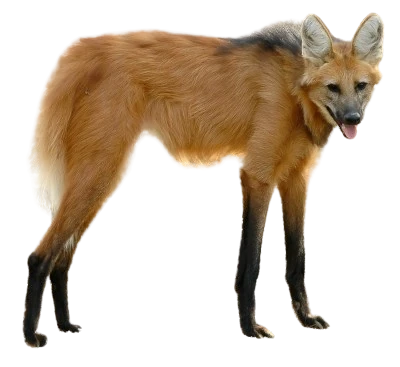
The Maned Wolf (Chrysocyon brachyurus) is a rare and remarkable canid native to the savannas and grasslands of South America, primarily found in Brazil, Bolivia, and Paraguay. With its long legs and distinctive mane, it stands out from other members of the canid family.
The Maned Wolf is a large canid, measuring between 70 and 90 cm at the shoulder and weighing between 20 and 30 kg. It has a reddish-brown to golden fur coat, with a black mane running from the neck down the back. Its slender build, long legs, and narrow muzzle allow it to move with ease in its habitat.
The Maned Wolf (Chrysocyon brachyurus) belongs to the Canidae family.
This wolf is the only member of the genus Chrysocyon and is closely related to other canids like the gray wolf and coyote, though it exhibits unique characteristics.
The Maned Wolf primarily inhabits savannas and open grasslands, preferring areas with sparse vegetation. It is found mainly in central and southern Brazil, but also in Bolivia and Paraguay. Its habitat is characterized by flat, grassy terrain where it can easily hunt and move.
Unlike gray wolves, the Maned Wolf is not a social animal and prefers to lead a relatively solitary life. It hunts alone or occasionally in pairs, and its movements are often solitary. It uses specific vocalizations to communicate, including soft howls that can be heard over long distances.
The Maned Wolf is an opportunistic omnivore, feeding mainly on small mammals, birds, fruits, and roots. It is also known to consume insects and reptiles when available. Its diet varies depending on the resources available in its habitat.
The Maned Wolf is classified as a vulnerable species by the IUCN due to habitat loss and hunting. While it is relatively adaptable, its population is declining, primarily due to deforestation and the expansion of agricultural lands.
The Maned Wolf, also known as Chrysocyon brachyurus, belongs to the Canid family. Its closest genetic cousins include the Crab-eating Fox (Cerdocyon thous) and the Pampas Fox (Lycalopex gymnocercus). These species share common characteristics, notably their adaptation to open environments and their varied diet.
Observing a Maned Wolf in its natural habitat is a fascinating experience. Here are some tips for a respectful observation:
By following these tips, you can observe the Maned Wolf while preserving its natural environment.